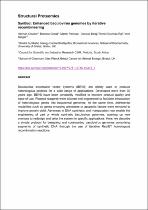JavaScript is disabled for your browser. Some features of this site may not work without it.
- ResearchSpace
- →
- Research Publications/Outputs
- →
- Book Chapters
- →
- View Item
| dc.contributor.author |
Crocker, H

|
|
| dc.contributor.author |
Gorda, B

|
|
| dc.contributor.author |
Pelosse, M

|
|
| dc.contributor.author |
Thimiri Govindaraj, Deepak B

|
|
| dc.contributor.author |
Berger, I

|
|
| dc.contributor.editor | Owens, R.J | |
| dc.date.accessioned | 2021-10-22T20:01:04Z | |
| dc.date.available | 2021-10-22T20:01:04Z | |
| dc.date.issued | 2021-05 | |
| dc.identifier.citation | Crocker, H., Gorda, B., Pelosse, M., Thimiri Govindaraj, D. & Berger, I. 2021. SynBac: Enhanced baculovirus genomes by iterative recombineering. In <i>Structural Proteomics</i>. R.J. Owens, Ed. S.l.: Springer, Humana. http://hdl.handle.net/10204/12136 . | en_ZA |
| dc.identifier.isbn | 978-1-0716-1406-8 | |
| dc.identifier.isbn | 978-1-0716-1405-1 | |
| dc.identifier.uri | DOI https://doi.org/10.1007/978-1-0716-1406-8_7 | |
| dc.identifier.uri | http://hdl.handle.net/10204/12136 | |
| dc.description.abstract | Baculovirus expression vector systems (BEVS) are widely used to produce heterologous proteins for a wide range of applications. Developed more than 30 years ago, BEVS have been constantly modified to improve product quality and ease-of-use. Plasmid reagents were tailored and engineered to facilitate introduction of heterologous genes into baculoviral genomes. At the same time, detrimental modalities such as genes encoding proteases or apoptotic factors were removed to improve protein yield. Advances in DNA synthesis and manipulation now enable the engineering of part or whole synthetic baculovirus genomes, opening up new avenues to redesign and tailor the system to specific applications. Here, we describe a simple protocol for designing and constructing baculovirus genomes comprising segments of synthetic DNA through the use of iterative Red/ET homologous recombination reactions. | en_US |
| dc.format | Abstract | en_US |
| dc.language.iso | en | en_US |
| dc.publisher | Springer, Humana | en_US |
| dc.relation.uri | https://pubs.acs.org/doi/10.1021/acsami.1c04132 | en_US |
| dc.source | Structural Proteomics | en_US |
| dc.subject | Autographa californica multiple nucleopolyhedrosis virus | en_US |
| dc.subject | AcMNPV | en_US |
| dc.subject | Baculovirus expression vector system | en_US |
| dc.subject | Genome engineering | en_US |
| dc.subject | Red/ET homologous recombination | en_US |
| dc.title | SynBac: Enhanced baculovirus genomes by iterative recombineering | en_US |
| dc.type | Book Chapter | en_US |
| dc.description.pages | 141-152 | en_US |
| dc.description.placeofpublication | New York | en_US |
| dc.description.note | Copyright © 2021 American Chemical Society. Due to copyright restrictions, the attached PDF file only contains the abstract of the full text item. For access to the full text item, please consult the publisher's website: https://doi.org/10.1021/acsami.1c04132 | en_US |
| dc.description.cluster | Next Generation Health | en_US |
| dc.description.impactarea | Synthetic Nanobiotech Biomachs | en_US |
| dc.identifier.apacitation | Crocker, H., Gorda, B., Pelosse, M., Thimiri Govindaraj, D., & Berger, I. (2021). SynBac: Enhanced baculovirus genomes by iterative recombineering. In R.J. Owens. (Ed.), <i>Structural Proteomics</i> Springer, Humana. http://hdl.handle.net/10204/12136 | en_ZA |
| dc.identifier.chicagocitation | Crocker, H, B Gorda, M Pelosse, Deepak Thimiri Govindaraj, and I Berger. "SynBac: Enhanced baculovirus genomes by iterative recombineering" In <i>STRUCTURAL PROTEOMICS</i>, edited by R.J Owens. n.p.: Springer, Humana. 2021. http://hdl.handle.net/10204/12136. | en_ZA |
| dc.identifier.vancouvercitation | Crocker H, Gorda B, Pelosse M, Thimiri Govindaraj D, Berger I. SynBac: Enhanced baculovirus genomes by iterative recombineering. In Owens RJ, editor.. Structural Proteomics. [place unknown]: Springer, Humana; 2021. [cited yyyy month dd]. http://hdl.handle.net/10204/12136. | en_ZA |
| dc.identifier.ris | TY - Book Chapter AU - Crocker, H AU - Gorda, B AU - Pelosse, M AU - Thimiri Govindaraj, Deepak AU - Berger, I AB - Baculovirus expression vector systems (BEVS) are widely used to produce heterologous proteins for a wide range of applications. Developed more than 30 years ago, BEVS have been constantly modified to improve product quality and ease-of-use. Plasmid reagents were tailored and engineered to facilitate introduction of heterologous genes into baculoviral genomes. At the same time, detrimental modalities such as genes encoding proteases or apoptotic factors were removed to improve protein yield. Advances in DNA synthesis and manipulation now enable the engineering of part or whole synthetic baculovirus genomes, opening up new avenues to redesign and tailor the system to specific applications. Here, we describe a simple protocol for designing and constructing baculovirus genomes comprising segments of synthetic DNA through the use of iterative Red/ET homologous recombination reactions. DA - 2021-05 DB - ResearchSpace DP - CSIR ED - Owens, R.J J1 - Structural Proteomics KW - Autographa californica multiple nucleopolyhedrosis virus KW - AcMNPV KW - Baculovirus expression vector system KW - Genome engineering KW - Red/ET homologous recombination LK - https://researchspace.csir.co.za PY - 2021 SM - 978-1-0716-1406-8 SM - 978-1-0716-1405-1 T1 - SynBac: Enhanced baculovirus genomes by iterative recombineering TI - SynBac: Enhanced baculovirus genomes by iterative recombineering UR - http://hdl.handle.net/10204/12136 ER - | en_ZA |
| dc.identifier.worklist | 25001 | en_US |






